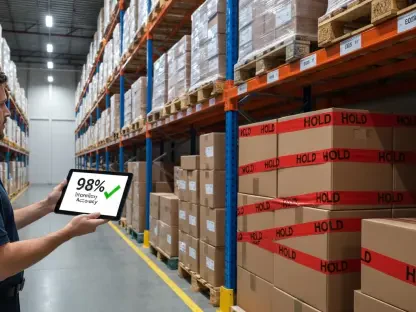In the fast-paced world of e-commerce, where a single delayed shipment can cost thousands of customers and tarnish a brand’s reputation, logistics stands as the backbone of success, and for many small-to-medium enterprises, every hour spent on supply chain tasks steals focus from innovation and growth. Picture a Dallas-based premium cookware company grappling with the chaos of international manufacturing, inventory mismanagement, and shipping delays. This is the reality many businesses face. Yet, for one company, a strategic partnership has turned this struggle into a streamlined triumph, showcasing how cutting-edge tools can redefine operational efficiency in today’s competitive market.
Why Logistics Can Make or Break a Business
The importance of a robust supply chain cannot be overstated in an era where consumers expect next-day delivery as standard. With global trade complexities and rising operational costs, businesses face mounting pressure to keep goods moving without hiccups. A recent study by the National Retail Federation indicates that 67% of customers abandon brands after a single delivery delay, underscoring the high stakes involved. For companies dealing with international suppliers, the challenges multiply—customs errors, freight miscalculations, and inventory shortages can derail even the most promising ventures.
This reality hits close to home for many e-commerce players striving to scale. The smallest misstep, like a miscalculated shipment from a factory in China, can lead to weeks of delays and lost revenue. Efficiency in logistics isn’t just a luxury; it’s a survival tactic in a landscape where consumer loyalty hinges on speed and reliability. This sets the stage for understanding why innovative solutions are no longer optional but essential for staying ahead.
Avacraft’s Journey from Chaos to Control
Enter Avacraft, a Dallas-based premium cookware brand that once wrestled with the logistical nightmares of managing a growing product line across multiple countries. Before adopting advanced tools, the company faced endless hours of manual inventory tracking and the daunting task of coordinating shipments from manufacturers in China and India. These hurdles bogged down operations, pulling focus away from product development and market expansion, and threatened to stall the brand’s momentum in a crowded industry.
The turning point came through a partnership with Amazon’s supply chain services, which offered a lifeline to streamline these cumbersome processes. By integrating tools designed for automation and global coordination, Avacraft transformed its operations from a tangle of inefficiencies into a model of precision. This shift didn’t just save time—it redefined how the company approaches scalability, proving that technology can be a game-changer for businesses willing to adapt.
Harnessing Amazon’s Tools for Operational Success
Diving deeper into this transformation reveals the power of specific Amazon services tailored for logistics challenges. Amazon Warehousing and Distribution (AWD) emerged as a cornerstone, automating inventory replenishment to Fulfillment by Amazon (FBA) locations. This eliminated the grueling manual coordination with third-party freight forwarders, slashing the time spent on supply chain tasks from 30 hours a week to a mere 5-6 for Avacraft’s leadership. The result was a seamless flow of stock, ensuring products were always ready for customer orders without constant oversight.
Another critical piece of the puzzle is Amazon Global Logistics (AGL), which tackled the complexities of international shipping head-on. With preloaded product specifications and instant freight quotes, AGL simplified customs documentation and duty calculations for Avacraft’s operations spanning multiple countries. This tool enabled swift coordination with manufacturers for loading operations, cutting through red tape that once delayed shipments by weeks. As the company expanded its product line to 40 items, this efficiency became a vital asset for maintaining pace with growth.
Looking ahead, anticipation builds for Amazon’s Global Warehousing and Distribution service, rolled out recently to offer storage closer to production sites. For a brand like Avacraft, this means inventory can be accessed as needed near manufacturing hubs, freeing up capital for innovation or new market entries. This forward-thinking solution highlights how Amazon continues to evolve its offerings, addressing the nuanced needs of e-commerce businesses navigating global supply chains.
A Leader’s Perspective on the Transformation
Hearing directly from Avacraft’s CEO, Asha Kangralkar, adds a personal layer to this story of change. Speaking at a recent Amazon Accelerate session and through follow-up correspondence, Kangralkar described AWD as “easy,” emphasizing how it maintains warehouse stock levels with minimal intervention. This automation lifted a significant burden, allowing her to redirect energy toward strategic priorities like product design and customer engagement.
Kangralkar also highlighted AGL’s impact on international logistics, noting how it streamlined customs processes that once consumed countless hours. “It’s a huge relief to have documentation and freight handled so efficiently,” she shared, recalling the seamless shift in managing shipments across borders. Her enthusiasm extends to upcoming Amazon services, which she believes will further optimize storage and distribution, painting a picture of a business leader empowered by technology to focus on vision over operational grind.
Lessons for Other Businesses Eyeing Efficiency
For other e-commerce ventures watching Avacraft’s success, practical steps emerge to mirror this logistical overhaul. Begin by pinpointing specific bottlenecks—be it inventory delays or shipping errors—and explore automation tools like FBA to offload order fulfillment burdens. Such systems can drastically cut manual workload, offering breathing room to tackle bigger goals without sacrificing service quality.
Additionally, businesses with global operations should consider services akin to AGL to simplify cross-border challenges. Tools that handle customs coordination and provide real-time freight insights can turn a logistical maze into a straightforward path. Staying updated on emerging solutions, such as global warehousing options, also ensures readiness to adapt storage strategies as production needs evolve, aligning with long-term growth plans.
Ultimately, the key lies in embracing technology as a partner rather than a hurdle. Assessing current systems against available innovations can reveal opportunities to save time and reduce errors. For any brand aiming to scale in today’s market, adopting such tools isn’t just about keeping up—it’s about setting the pace for competitors to follow.
Reflecting on a Path Forward
Looking back, Avacraft’s journey with Amazon’s supply chain tools marked a pivotal chapter in overcoming the logistical chaos that once threatened its growth. The adoption of automated inventory systems and global shipping solutions reshaped daily operations, turning hours of manual toil into strategic opportunities. This transformation stood as a testament to the power of technology in leveling the playing field for smaller enterprises.
The broader implication was clear: businesses no longer needed to accept supply chain struggles as inevitable. By seeking out and integrating tailored solutions, companies could reclaim time and resources for innovation. As the e-commerce landscape continues to evolve, the next step for many would be to evaluate their own logistics frameworks, identifying gaps where modern tools could drive similar breakthroughs.
Beyond individual success, this story pointed to a collective shift toward efficiency in an industry defined by speed. The challenge ahead rested in staying agile—continuously exploring new services and strategies to meet rising consumer demands. For any business inspired by this example, the path forward involved a commitment to adaptation, ensuring that logistics became a strength rather than a stumbling block in the pursuit of lasting impact.









